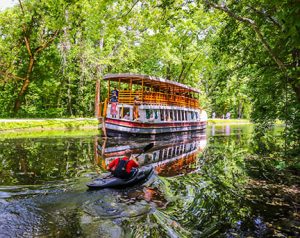
The Charles F. Mercer canal boat is passed in the C&O Canal by a kayaker. Photo: Paul Graunke
The Chesapeake and Ohio Canal National Historical Park runs from Georgetown in Washington D.C. to Cumberland, Maryland. The Park, locally known as the C&O Canal, preserves 200 years of America’s history and offers over 20,000 acres for visitors to enjoy nature and recreate. The C&O Canal Trust is the official nonprofit partner for the C&O Canal National Historical Park, dedicated to raising funds and managing programs to preserve the Park.
>> Download a one-sheet about the C&O Canal, including a map
Fast Facts
- 184.5 mile-long towpath that runs the length of the Park. Popular for hiking and biking.
- Over 1,300 historic structures.
- 113 rare and threatened plants and animals.
- 20,000 acres.
- Largest national park in Maryland.
- Over 5 million visitors in 2022.
- 16th most visited national park in the nation (2021).
- Visitors spent an estimated $84.5 million in local gateway regions.
- 2021 was the 50th anniversary of the canal becoming a national park.
- Runs through Washington D.C. and four counties in Maryland: Montgomery County, Frederick County, Washington County, and Allegany County.
- Park Visitor Centers are located at Great Falls, Brunswick, Williamsport, Hancock, and Cumberland.
- Vegetation along 260 streams, three bodies of water, and 27 springs helps filter runoff and protect quality before it reaches the Potomac River and the Chesapeake Bay.
- The towpath connects at Cumberland, MD, to the Great Allegheny Passage, a 150-mile trail that goes all the way to Pittsburgh. It is on the bucket list of many cyclists to bike all 330 miles from Pittsburgh to Washington D.C.
History
- The vision of the canal was to transport goods including coal, lumber, and agricultural products from the fertile Ohio River valley to eastern markets, while avoiding the challenges posed by the shallow, rocky Potomac River.
- The C&O Canal Company broke ground on the project in 1828.
- The canal reached Cumberland in 1850, losing the race west to the Baltimore & Ohio Railroad, which had reached Cumberland eight years prior. The C&O Canal Company operated the canal until 1924, when it terminated operations due to flood damage and the superiority of the railroad.
- The canal also played a role in the Civil War. Confederate troops sought to damage the canal to prevent the transportation of supplies by the Union. Confederate and Union troops crossed the Potomac River numerous times.
- In 1950, Congress developed plans to build a parkway. Supreme Court Justice William O. Douglas, adamantly opposed this plan and rallied support for saving the canal by hiking from Cumberland to Washington D.C.
- In 1971, the C&O Canal became a National Historical Park.
Recreation
- Climbing
- Carderock is considered some of the best rock climbing in the D.C. area.
- Biking
- Biking the length of the canal (184.5 miles) is one of the more popular recreational activities for visitors. Bikers can connect to the Great Allegheny Passage and travel the 330 miles between Washington D.C. and Pittsburgh, PA. A typical C&O Canal bike trip takes three to five days.
- The canal is designated as U.S. Bicycle Route 50.
- The canal is the first section of the Great American Rail Trail, a long distance trail being developed to connect Washington D.C. to Washington state by bike path.
- Hiking
- There are 347 miles of trails in the Park.
- The Great Falls area has 14 miles of trails featuring the challenging Billy Goat Trail A and the Great Falls Overlook.
- The Paw Paw Tunnel is 3,118 feet long and the two-mile Paw Paw Tunnel Trail runs above the tunnel.
- Horseback Riding
- Horses are allowed on the towpath from Swains Lock (mile 16.1) to Offutt Street (mile 181.8).
- Boating
- Non-motorized boats are allowed in the watered section of the canal.
- There are many boat ramps along the canal.
- There are white water class IV-V rapids near the Great Falls area and class II-II rapids near the Harpers Ferry area.
- Camping
- 31 rustic campsites from Potomac to Cumberland are available on a first-come, first-served basis. Sites have a chemical toilet, water, a picnic table, and a grill.
- Five drive-in campsites can be reserved ahead of time.
- Nearby Attractions
- Seneca Creek State Park
- Appalachian National Scenic Trail
- Harpers Ferry National Historical Park
- Antietam National Battlefield
- Fort Frederick State Park
- Western Maryland Rail Trail
- Green Ridge State Forest
- The Park is included in:
- Heritage Montgomery Heritage Area
- Heart of the Civil War Heritage Area
- Passages of the Western Potomac Heritage Area
- C&O Canal Scenic Byway
- Potomac Heritage National Scenic Trail
- Journey Through Hallowed Ground National Heritage Area
- Appalachian Forest National Heritage Area
Planning Your Visit
Visit our Canal Quarters page to learn about this interpretive program. Seven lockhouses are furnished to depict different eras of the canal and are available for overnight stay.
The canal brought industry and prosperity to the Canal Towns. Now visitors enjoy the Canal Towns for the food, services, and unique history the towns provide. The towns benefit economically from trail tourism.
Our C&O Canal Explorer mobile app features over 600 points of interest and trip planning tools.
Social Media
Stay up to date with our Facebook, Instagram, Twitter, and LinkedIn pages. Our hashtag is #candocanaltrust.
Media Inquiries
A variety of high-resolution photographs are available upon request.





